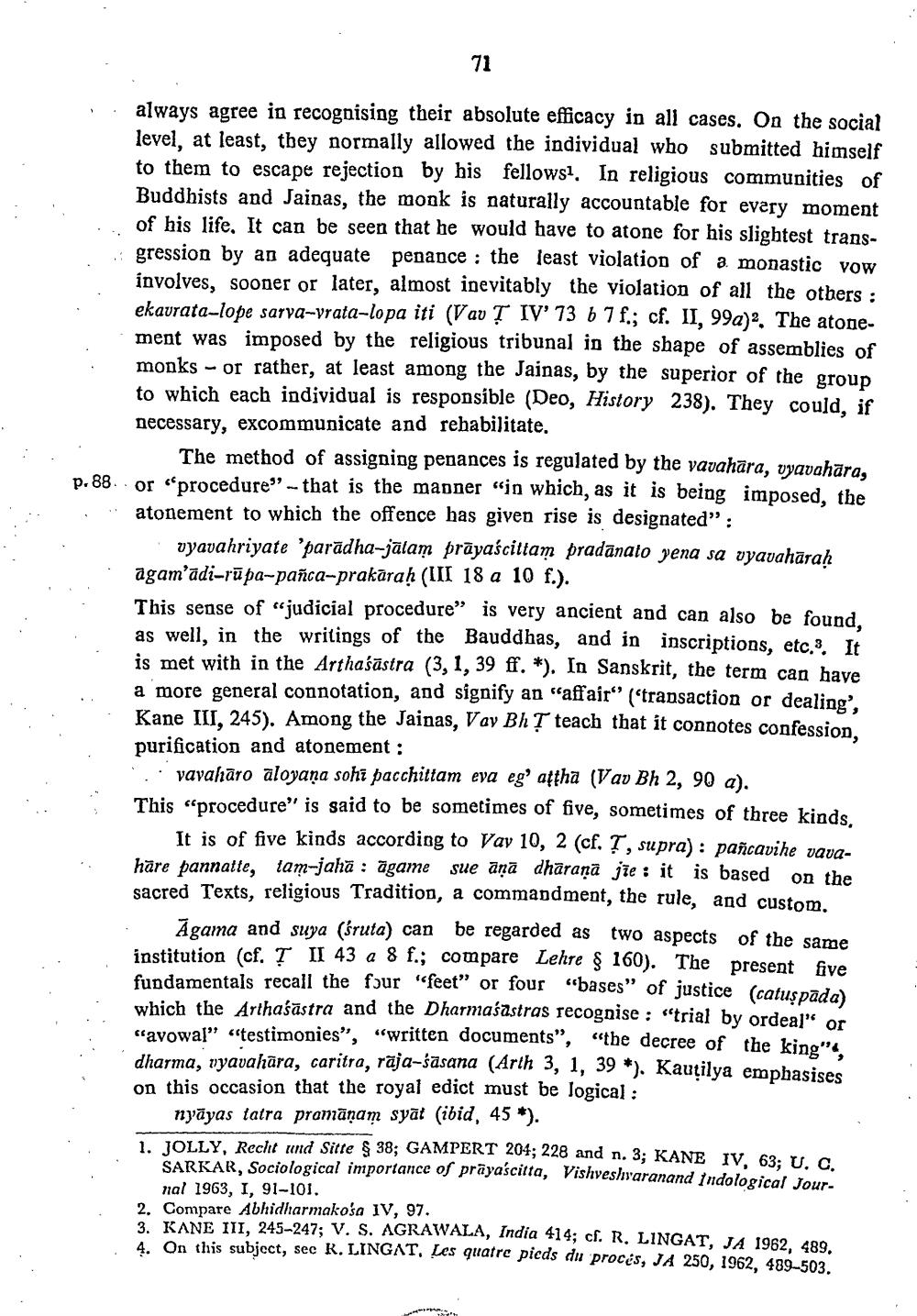________________
I
p. 88
always agree in recognising their absolute efficacy in all cases. On the social level, at least, they normally allowed the individual who submitted himself to them to escape rejection by his fellows?. In religious communities of Buddhists and Jainas, the monk is naturally accountable for every moment of his life. It can be seen that he would have to atone for his slightest transgression by an adequate penance : the least violation of a mi involves, sooner or later, almost inevitably the violation of all the others : ekavrata-lope sarva-vrata-lopa iti (Vav Ţ IV' 73 6 7f.; cf. II, 99a). The atonement was imposed by the religious tribunal in the shape of assemblies of monks - or rather, at least among the Jainas, by the superior of the group to which each individual is responsible (Deo, History 238). They could, if necessary, excommunicate and rehabilitate.
The method of assigning penances is regulated by the vavahāra, vyavahāra, or procedure”- that is the manner “in which, as it is being imposed, the atonement to which the offence has given rise is designated":
vyavahriyate 'parādha-jālam prāyaścittam pradanato yena sa vyavahārah agam'ādi-rūpa-pañca-prakāraḥ (III 18 a 10 f.). This sense of “judicial procedure” is very ancient and can also be found. as well, in the writings of the Bauddhas, and in inscriptions, etc. 3. It is met with in the Arthaśāstra (3, 1, 39 ff. *). In Sanskrit, the term can have a more general connotation, and signify an “affair" ('transaction or dealing'. Kane III, 245). Among the Jainas, Vay Bhs teach that it connotes confession. purification and atonement : ... vavahāro aloyaņa sohi pacchittam eya eg' aftha (Vav Bh 2, 90 a). This procedure" is said to be sometimes of five, sometimes of three kinds
It is of five kinds according to Vay 10, 2 (cf. ?, supra): pancavihe vauahäre pannatte, tam-jaha : Ogame sue anā dhāraņā jīe : it is based on the sacred Texts, religious Tradition, a commandment, the rule, and custom
Zeama and suya (śruta) can be regarded as two aspects of the same institution (cf. T II 43 a 8 f.; compare Lehre § 160). The present five fundamentals recall the four "feet" or four "bases" of justice which the Arthaśāstra and the Dharmasastras recognise : "trial by ordea!" sayowal” (testimonies", "written documents”, “the decree of the king" dharma, vyavahāra, caritra, raja-śāsana (Arth 3, 1, 39 *). Kautilya emphasises on this occasion that the royal edict must be logical :
nyāyas tatra promānam syāt (ibid, 45 *). I TOLLY, Recht und Sitte § 38; GAMPERT 204; 228 and n. 3; KANE IV, 63; U. C.
SARKAR, Sociological importance of prayascitta, Vishveshwaranand indological Jour
nal 1963, I, 91-101. 2. Compare Abhidharmakosa IV, 97. 3. KANE III, 245-247; V. S. AGRAWALA, India 414; cf. R. LINGAT, JA 1962. 489
On this subject, sec R. LINGAT. Les quatre pieds du proces, JA 250, 1962. 489-503.




